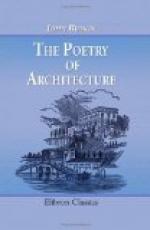34. III. Elegance of feeling. We never can prevent ourselves from imagining that we perceive in the graceful negligence of the Italian cottage, the evidence of a taste among the lower orders refined by the glory of their land, and the beauty of its remains. We have always had strong faith in the influence of climate on the mind, and feel strongly tempted to discuss the subject at length; but our paper has already exceeded its proposed limits, and we must content ourselves with remarking what will not, we think, be disputed, that the eye, by constantly resting either on natural scenery of noble tone and character, or on the architectural remains of classical beauty, must contract a habit of feeling correctly and tastefully; the influence of which, we think, is seen in the style of edifices the most modern and the most humble.
35. Lastly, Dilapidation. We have just used the term “graceful negligence”: whether it be graceful, or not, is a matter of taste; but the uncomfortable and ruinous disorder and dilapidation of the Italian cottage is one of observation. The splendor of the climate requires nothing more than shade from the sun, and occasionally shelter from a violent storm: the outer arcade affords them both; it becomes the nightly lounge and daily dormitory of its inhabitant, and the interior is abandoned to filth and decay. Indolence watches the tooth of Time with careless eye and nerveless hand. Religion, or its abuse, reduces every individual of the population to utter inactivity three days out of the seven; and the habits formed in the three regulate the four. Abject poverty takes away the power, while brutish sloth weakens the will; and the filthy habits of the Italian prevent him from suffering from the state to which he is reduced. The shattered roofs, the dark, confused, ragged windows, the obscure chambers, the tattered and dirty draperies, altogether present a picture which, seen too near, is sometimes revolting to the eye, always melancholy to the mind. Yet even this many would not wish to be otherwise. The prosperity of nations, as of individuals, is cold and hard-hearted, and forgetful. The dead die, indeed, trampled down by the crowd of the living; the place thereof shall know them no more, for that place is not in the hearts of the survivors for whose interests they have made way. But adversity and ruin point to the sepulcher, and it is not trodden on; to the chronicle, and it doth not decay. Who would substitute the rush of a new nation, the struggle of an awakening power, for the dreamy sleep of Italy’s desolation, for her sweet silence of melancholy thought, her twilight time of everlasting memories?




